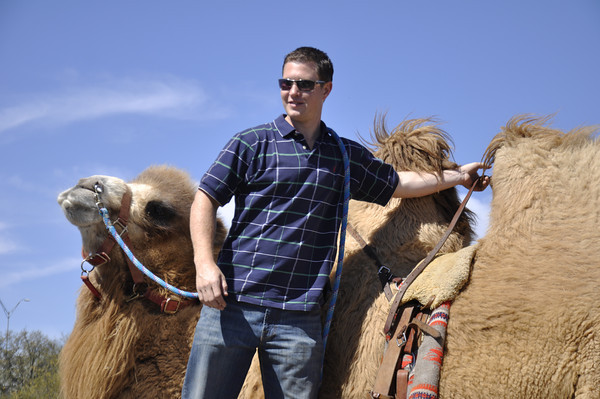Not Your Everyday Job: Man Sells $5 Rides on His Camel
By Mary Ellen Knewtson
For Reporting Texas
AUSTIN — On a late Saturday morning at a lot near Austin-Bergstrom International Airport, a twice-weekly flea market is in full swing. A Tejano band begins its first set. The beer is flowing. More than 1,000 people — mostly Spanish-speaking families — roam among vendors peddling fresh eggs, live chickens, unlicensed Spiderman dolls, neon leggings, potted plants, bridesmaid dresses and all things Virgen de Guadalupe.
It is difficult to compete with the spectacle that is the 812 Outdoor Market, but being a 3,000-pound Bactrian camel with two fur-tufted hulks of fat doesn’t hurt.
Four men gawk. A 10-year-old girl leans over a movie theater-style divider separating her from Caesar the camel.
“Would you like to ride him?” owner Edwin Snell asks. “It costs $5.” The 24-year-old camel wrangler stands atop a homemade four-step staircase and affectionately scratches Caesar’s nose.
Caesar, 15 years old, stands 8 1/2 feet tall and carries himself regally. Intelligent eyes regard onlookers through a long, full mane.
Snell makes his living selling rides on Caesar, taking him to flea markets, street corners and other sites where curious people are willing to pay for a brief, unusual experience.
At the Austin market, the group of onlookers has grown to 30, and families begin to queue at the staircase.
Snell hoists the 10-year-old girl onto the thin saddle wedged between Caesar’s humps, which rise above her head. She hugs the front hump; her arms barely stretch around it. At a signal from Snell, Caesar lifts a dinner-plate-sized hoof and proceeds forward, unhurried.
The camel was not always so cooperative. Caesar’s first owner in North Dakota sold the young rambunctious camel to the Snell family in 2000. Snell recalls the man saying, “If you can catch him, you can take him.”
After a truck chase all over the property, 11-year-old Snell and his father muscled Caesar into their trailer, and left for their ranch in Clovis, N.M., hoping to add something exotic to the pony rides they offered there.
For two months, the Snells couldn’t even get near Caesar. Then the young Snell began cajoling Caesar with treats. It still took three years to fully break the camel for riding.
At the flea market, the girl’s father walks alongside Caesar, recording the ride with his cell phone camera. Four minutes later, they arrive back at the steps, and Snell helps the girl down. “It was cool,” she says.
Several rides later, Thomas Resendez, a 65-year-old retired postal worker, makes his way to the front of the line.
“Will I fit?” asks Resendez, whose gut is the size of a beach ball.
“Oh, you’ll be fine,” Snell says. “He’s strong.”
Resenndez climbs the stairs and swings into the saddle, but is forced to sit at a slant because his midsection won’t fit between Caesar’s humps. He does not look comfortable.
And yet, after dismounting, Resendez has become a Caesar fan. He said his weeks are stressful and he looks for a chance to relax and forget. “I feel like I just had a beer,” he says. “We don’t get stuff like this around here.”
Snell has run into permit problems in some cities. He says he’s been banned in Lubbock, where animal services officers ticketed him after he set up his ride area. When he continued to offer rides, he said the officers threatened to arrest him and impound Caesar.
In Austin, it took Snell three months in 2012 to obtain the correct permits. A city animal services officer confirmed that Snell has the proper permits, which he brings to ride sites. While he clears snags with large cities such as Austin or San Antonio, Snell bounces between small cities including Temple, Kyle and New Braunfels. He also has necessary paperwork from the U.S. Department of Agriculture.
Doug Baum, owner of the Texas Camel Corps, says he has no ethical issue about camel rides in general. Baum, who’s spent 20 years working with camels in the United States and Egypt and educating people about them, says camels have remarkable abilities to thrive in barren climates and extreme circumstances.
He adds that camels live an average of 10 to 15 years longer in the United States than in the Middle East, where they are used as work animals. In the U.S., with good fortune and veterinary care, it is not unheard of for a camel to live to 50, Baum says.
The American Society for the Prevention of Cruelty to Animals could not speak directly about Snell, spokesperson Bret Hopman said, but is not opposed to using animals for work or rides as long as they are not in pain, injured or distressed. Snell says it would be against his own interests to mistreat Caesar.
Snell won’t say what he makes from camel rides, but six or seven hours of five-minute camel rides at $5 apiece can add up. Caesar will also come to private parties for a $500 minimum. Snell keeps his housing costs low by crashing with friends when possible, and uses Craigslist to locate a suitable place for Caesar in each city. After his permit issues last year, Snell is hoping for smoother sailing this year, now that he’s familiar with requirements that vary from town to town.
Camel and owner will be traveling around Central Texas until early June. While Caesar is not picky, Snell would like to avoid the Texas heat. The pair will leave for Colorado when the weather changes.
